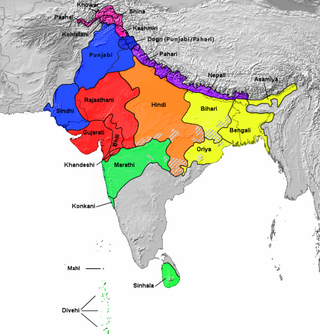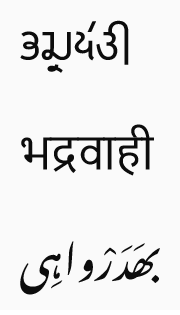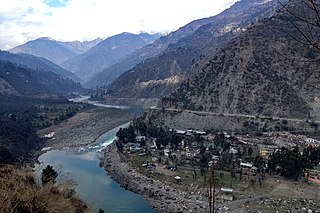
Kashmiri or Koshur is a Dardic Indo-Aryan language spoken by around 7 million Kashmiris of the Kashmir region, primarily in the Kashmir Valley of the Indian-administrated union territory of Jammu and Kashmir. Kashmiri has split ergativity and the unusual verb-second word order.

The Dardic languages, or Hindu-Kush Indo-Aryan languages, are a group of several Indo-Aryan languages spoken in northern Pakistan, northwestern India and parts of northeastern Afghanistan. This region has sometimes been referred to as Dardistan.

The Northern Indo-Aryan languages, also known as Pahāṛi languages, are a proposed group of Indo-Aryan languages spoken in the lower ranges of the Himalayas, from Nepal in the east, through the Indian states of Jammu and Kashmir, Uttarakhand, Himachal Pradesh and Punjab was coined by G. A. Grierson.

Pahari-Pothwari is an Indo-Aryan language variety of Lahnda group, spoken on the Pothohar Plateau in the far north of Punjab, Pakistan, as well as in most of Pakistan-administered Azad Kashmir and in western areas of Indian-administered Jammu and Kashmir, is known by a variety of names, the most common of which are Pahari, and Pothwari.

Doda district is an administrative district of the Jammu division of Indian-administered Jammu and Kashmir in the disputed Kashmir region.

Bhadarwahi (Bhadrawahi) is an Indo-Aryan language of the Western Pahari group spoken by the Bhadarwahi people of the Bhaderwah region of Indian administered Jammu and Kashmir.
Padri is a dialect spoken in the Padar valley in Kishtwar district in the Indian territory of Jammu and Kashmir. It belongs to the Bhadarwahi group of dialects, and is classified as a member of the Western Pahari branch of the Indo-Aryan languages. It is very similar to the Pangwali language of Pangi, Himachal Pradesh.

The Chenab Valley is a river valley formed by the Chenab River. The term is also used collectively for Doda, Kishtwar and Ramban districts of Jammu Division in the Indian-administered Jammu and Kashmir. These districts were formerly part of a single district, called Doda.

Kishtwari or Kashtwari is a northern Indo-Aryan language closely related to the Kashmiri language, with strong influences from neighboring Western Pahari varieties, spoken in the Kishtwar district of Jammu and Kashmir, India.
Saraz or Siraj is a hilly region in the eastern part of the Jammu division of Jammu and Kashmir in northern India. Historically a pargana within the erstwhile state of Kishtwar, the region currently takes up the northern half of Doda district and parts of neighbouring Ramban and Kishtwar districts. Its population in 2011 stood at 180,000 people. The region is defined mainly on the basis of linguistics where the majority of people speak Sarazi as their mother tongue.

Bhalessa is a geographical area within Doda district in the Jammu region of India-administered Kashmir. It consists of the Bunjwah and Bhalessa Valleys, and comprises the three Tehsils of Kahara, Chilly Pingal and Gandoh.
Khāṣi is an Indo-Aryan dialect of Jammu and Kashmir, India. It belongs to the Western Pahari group and is spoken in some of the mountainous areas north of Jammu.
The Pahari people or Pahari-speaking people is a cover term for a number of heterogeneous communities inhabiting in Jammu and Kashmir and also some parts of Pakistan administered Azad Kashmir who speak Pahari languages/dialects.
Pogali, or Poguli, is an Indo-Aryan language spoken in parts of the Chenab Valley in Jammu region of Jammu and Kashmir, India. Its area encompasses the Pogal and Paristan, Ramsu Banihal Khari Reasi valleys, and currently falls within the boundaries of Ramban district's Pogal Paristan tehsil.Poguli, while based on Kashmiri, is much mixed with Pahari and Lahndâ, and forms a transition dialect. In 1911 the number of speakers was reported to be 8,158.Like its neighbours Sarazi and Rambani, Poguli is intermediate between Kashmiri and Western Pahari.
Rambani is an Indo-Aryan language variety spoken in Ramban district, which is located in the mountainous parts of the Jammu region of Jammu and Kashmir, India.
Badanoo is a village in Thathri tehsil of Doda district in Jammu and Kashmir. It is located at least 36 kilometres from its district headquarters. This village is the part of Patwar Halqa Jangalwar.
Bhaderwahi people are an Indo-Aryan ethnolinguistic group native to the Bhaderwah Valley in the Doda district of Jammu and Kashmir, India, who traditionally speak the Bhadarwahi language.
Sarazi people are an Indo-Aryan ethnolinguistic group inhabiting the Saraz region of the Jammu division in Jammu and Kashmir, India. Their primary language is Sarazi, classified as a member of the Western Pahari language family. While primarily Hindu, the Sarazi people also include Muslim communities who speak Sarazi as a second language.









